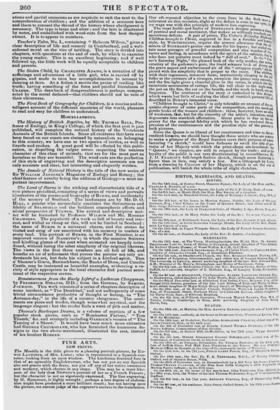Sabbation, Honor Neale, and other Poems, by RICHARD CHENEYIX TRENCH,
are short pieces, principally of a religious character, written in imitation of WORDSWORTH; but wanting the profound thought and imaginative feeling that nerve his sim- plicity, as well as the originality and fecundity of ideas thatcon- etitute the wealth of the poetical imagination.
The Pleasures of Piety, a poem in eight books, by the Reve- rend RoLiEue WILSON, A.M., is a high-sounding cento of blank verse, in the solemn strain prescribed to sacred poetry ; that might have taken the lowest place on the list of " Pleasures" which have been sung or said in metre, had it appeared at a time when readers had leisure and relish for commonplace poetry.
Poetical Illustrations of Passages of Scripture, by EMILY TAYLOR, are merely lyrical paraphrases of Bible texts, that are neither strengthened nor enriched by the process of' metrical dilution.
CHILDREN'S BOOKS.
The Child's Own Bible consists of a judicious selection of narratives of the leading events recorded in the Scriptures, given in the words of the inspired writers, with only such verbal alter
ations and partial omissions as are requisite to suit the text to the comprehension of children ; and the addition of a sentence here and there to connect the thread of the history where abridgment is necessary. The type is large and clear ; and the text is illustrated by notes, and embellished with wood-cuts from the best designs extant. It is to appear in numbers.
Teacher's Tales, No. I., containing " Rebecca "Wilson," gives a clear description of life and scenery in Cumberland, and a well- enforced moral on the vice of tattling. The story is divided into chapters, with questions at the end of each, by which to examine the young reader. This is an excellent beginning ; and if well followed up, the little work will be equally acceptable to children and parents.
The Stolen Child, by CHARLOTTE ADAMS, is a narrative of the sufferings and adventures of a little girl, who is carried off by gipsies, and made to turn her accomplishments to account by dancing at fairs. As a fiction it merits the praise of reading like truth; having something of the force and painful literalness of CRABBE. The drawback of disagreeableness is perhaps compen- sated by the moral deduced—that children should not be vain of their cleverness.
The First Book of Geography for Children, is a concise and in- telligent account of the different countries of the world, pleasant to read and easy for children to understand.
MISCELLANEOUS.
The History of British Reptiles, by Mr. THOMAS BELL, Pro- fessor of Zoology, in King's College, of which the first part is just published, will complete the natural history of the Vertebrate Animals of the British Islands. Since all creatures that have ever been found on our coasts are claimed by naturalists as belonging to this country, we have one or two species of turtles, as well as lizards and snakes. A great good will be effected by this publi- cation, in dispelling the vulgar errors respecting the noxious character of this class of animals, that are for the most part as harmless as they are beautiful. The wood.cuts are the perfection of this style of engraving and the descriptive accounts are not only accurate and clear, but interesting and elegantly written.
The Annals of Natural History is the title of the new series of Sir WILLIAM JARDINE'S Magazine of Zoology and Botany ; the chief feature of novelty being the addition of Geology—a most im- portant improvement.
The Land of Burns is the striking and characteristic title of a new picture periodical, consisting of a series of views and portraits illustrative of the poems and biography of BURNS, and incidentally of the scenery of Scotland. The landscapes are by Mr. D. O. HILL, a painter who successfully emulates the distinctness and fidelity of STANFIELD and the brilliant atmospheric effects and ai3rial perspective of TURNER. The critical and descriptise mat- • ter will be furnished by Professor WILSON and Mr. ROBERT CHAMBERS. The popularity of a work so full of beauty and inte- rest, and withal so cheap as this, will not be limited to Scotland : the name of BURNS is a universal charm, and the scenes he visited and sung of are associated with his memory in readers of every land. The portrait of BURNS, in the First Number, is an improved version of NASMYTH'S ; in which the massive features
and kindling glance of the poet when animated are happily intro- duced, without losing the sober simplicity of the original likeness. The views in the first three numbers are all full of life, and
breathe an air of refinement that proves the painter not only un- derstands his art, but feels his subject in a kindred spirit. Tam o' Shunter's Grave, Bannockburn, the Banks of Doon, and Cassilis Castle, may be instanced as beautiful examples, evidencing a va- riety of style appropriate to the local character dnd poetical senti- ment of the respective scenes.
Reminiscences from the Early Life•of a Lutheran Clergyman, by FREDERICK STRAUSS, D.D.; from the German, by SAMUEL JACKSON. This work consists of a series of chapters descriptive of some incident, as "The Deathbed," and not unfrequently of some trivial circumstance productive of thought or feeling, as "The Autumn-day," in the life of a country clergyman. The senti- ments are pious and tender, though somewhat mystical, and the language elegant : but the reader feels a want of pith and matter.
Thomas's Burlesque Drama, is a volume of reprints of a few popular stock pieces, such as " Bombastes Furioso," "Tom Thumb," &c. and strangely including GARRICK'S version of " The Taming of a Shrew." It would have been much more attractive had GEORGE CRUIKSHANK, who has furnished the humorous de- signs to the two above-mentioned, illustrated the rest, instead of his brother ROBERT.



























 Previous page
Previous page